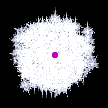|
|||
|
Anvil Tips | Quartz' Quarry | Hit Points | Theta | Adding Textures
|
|||
|
All About Theta |
| Actually, there isn't really a hell of a lot to say on this subject.
Basically, theta error isn't a random spread like most people think,
as far as I can tell, the number you type in is actually the index number
of the pattern you want to use. What I've done below is take snapshots
of those patterns (up to #10) so other people can get a good idea of
what's going on. Marathon's hashing functions seem to be very good, so the latter of these pictures are actually composites created from several screen captures. (What this means for those of you who don't speak programmer is that the pattern isn't all that obvious, and that any given 'shot slot' may take quite a while to be chosen. There's a small blurb about hash tables and collisions at the bottom of this page) |
1 |
 |
2 |
 |
3 |
 |
4 |
 |
5 |
 |
6 |
 |
7 |
 |
8 |
 |
9 |
 |
10 |
 |
| This last picture |center| demonstrates a way around these patterns. For this, I turned on horizontal and vertical wander in the shot's properties, and set the theta to 0. (The spread that results from turning the 'wanders' on varies with the speed of the projectile. For this example, the fusion bolts were traveling at '1024') |
2 |
wander @ 1024 |
3 |
 |
 |
 |
| ... And that's about it. I dunno if this helps anybody, but I found
it interesting. If for some reason you want to contact me (to yell at me about wasting my time or whatever), my email addy is quartz@sneakertech.com. |
Anvil Tips |
Quartz' Quarry | Hit Points
| Theta | Adding Textures
![]()